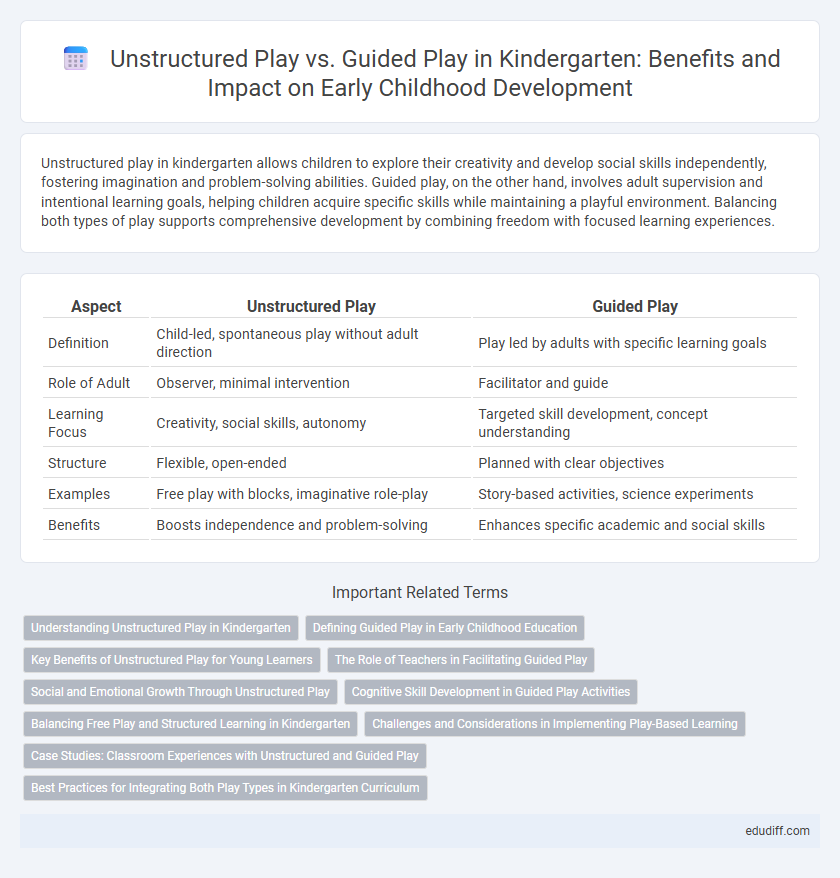Unstructured play in kindergarten allows children to explore their creativity and develop social skills independently, fostering imagination and problem-solving abilities. Guided play, on the other hand, involves adult supervision and intentional learning goals, helping children acquire specific skills while maintaining a playful environment. Balancing both types of play supports comprehensive development by combining freedom with focused learning experiences.
Table of Comparison
| Aspect | Unstructured Play | Guided Play |
|---|---|---|
| Definition | Child-led, spontaneous play without adult direction | Play led by adults with specific learning goals |
| Role of Adult | Observer, minimal intervention | Facilitator and guide |
| Learning Focus | Creativity, social skills, autonomy | Targeted skill development, concept understanding |
| Structure | Flexible, open-ended | Planned with clear objectives |
| Examples | Free play with blocks, imaginative role-play | Story-based activities, science experiments |
| Benefits | Boosts independence and problem-solving | Enhances specific academic and social skills |
Understanding Unstructured Play in Kindergarten
Unstructured play in kindergarten fosters creativity and social skills by allowing children to explore materials and ideas freely without adult direction. This type of play supports cognitive development through imagination, problem-solving, and self-regulation. Research shows that unstructured play enhances emotional resilience and promotes intrinsic motivation among early learners.
Defining Guided Play in Early Childhood Education
Guided play in early childhood education involves intentional adult involvement that shapes the learning environment while preserving child-led exploration, promoting cognitive and social development. It balances freedom and structure by providing specific learning goals within playful activities, enhancing problem-solving and creativity. Research shows this approach improves engagement and supports foundational skills essential for kindergarten readiness.
Key Benefits of Unstructured Play for Young Learners
Unstructured play in kindergarten fosters creativity, problem-solving, and social skills by allowing children to explore and make decisions independently. This form of play enhances cognitive development through open-ended activities that stimulate imagination and self-expression. Research indicates that unstructured play promotes emotional resilience and encourages intrinsic motivation, crucial for holistic early childhood growth.
The Role of Teachers in Facilitating Guided Play
Teachers play a crucial role in facilitating guided play by creating structured environments that balance child autonomy with intentional learning goals. They observe children's interests and subtly introduce educational materials and prompts that encourage problem-solving, social interaction, and creativity. This approach enhances cognitive and language development while maintaining the intrinsic motivation and joy found in unstructured play.
Social and Emotional Growth Through Unstructured Play
Unstructured play in kindergarten fosters social and emotional growth by allowing children to explore relationships, practice empathy, and develop problem-solving skills in a natural environment. This freeform interaction encourages emotional regulation and peer collaboration without adult direction, promoting confidence and independence. Research shows that unstructured play supports brain development related to social cognition and self-expression more effectively than strictly guided activities.
Cognitive Skill Development in Guided Play Activities
Guided play activities in kindergarten enhance cognitive skill development by combining child-led exploration with adult scaffolding, which promotes problem-solving, memory, and language abilities. Unlike unstructured play, guided play provides targeted opportunities for children to engage in goal-oriented tasks while maintaining a sense of autonomy. Research shows that this balance fosters executive functions and critical thinking, supporting early academic success.
Balancing Free Play and Structured Learning in Kindergarten
Balancing free play and structured learning in kindergarten enhances children's development by integrating unstructured play with guided play. Unstructured play fosters creativity, social skills, and problem-solving through child-led activities, while guided play incorporates adult support and specific learning goals to build foundational academic skills. Combining both approaches creates a dynamic environment that supports cognitive, emotional, and physical growth in early childhood education.
Challenges and Considerations in Implementing Play-Based Learning
Implementing play-based learning in kindergarten faces challenges such as balancing unstructured play, which fosters creativity and social skills, with guided play that aligns activities with curriculum goals and learning outcomes. Educators must consider classroom dynamics, available resources, and teacher training to effectively facilitate both types of play while ensuring developmental appropriateness. Addressing assessment difficulties and diverse student needs remains crucial for successful integration of play-based learning strategies.
Case Studies: Classroom Experiences with Unstructured and Guided Play
Case studies in kindergarten classrooms reveal that unstructured play fosters creativity and social skills by allowing children to explore materials freely, while guided play enhances cognitive development through targeted activities led by teachers. Research shows a balanced integration of both approaches optimizes learning outcomes, with unstructured play promoting problem-solving and guided play supporting language and numeracy skills. Observations indicate that collaborative play scenarios, when scaffolded by educators, significantly improve children's engagement and concept retention.
Best Practices for Integrating Both Play Types in Kindergarten Curriculum
Balancing unstructured play with guided play in kindergarten curriculum enhances cognitive, social, and emotional development by fostering creativity and problem-solving skills alongside targeted learning outcomes. Best practices include scheduling dedicated time for free exploration while incorporating teacher-led activities that align with educational goals and adapt to children's interests and developmental stages. Integrating assessment methods to observe engagement and learning progress during both play types ensures a responsive and effective play-based learning environment.
Unstructured play vs Guided play Infographic

 edudiff.com
edudiff.com